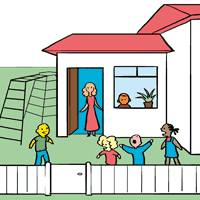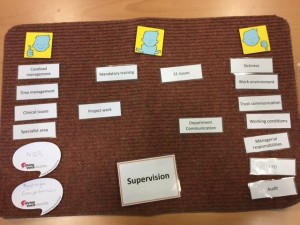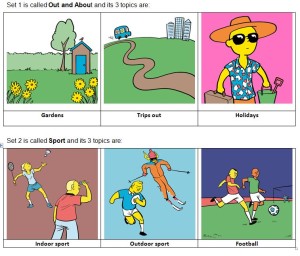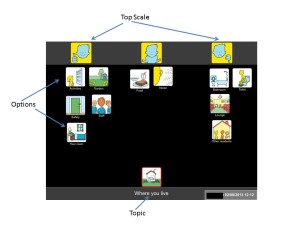Laura, shares a story from a speech and language therapy colleague. Her 4 year old daughter was getting upset at the thought of going to nursery; she wanted to see if using a Talking Mat might shed some light on why she was upset as the reasons were unclear.
Topic: Nursery
Top Scale: Like/ Don’t know/ Don’t Like
Options: 14 in total, focusing on different aspects of Nursery involving staff, other children, activities and environment.
The parent reports that her child was very engaged when doing the Mat, and took the photo of her completed mat at the end. Mum took the role of the ‘Listener’ however Dad was also there watching, so the child had the attention of both her parents.
The completed mat indicated that the child liked a number of aspects about nursery, however did not like ‘smell’, ‘sound’ and playing games with other children outside. The parent then fed this information back to nursery staff who are now monitoring these areas in order to gain further information.
This further information from staff will help to provide ideas regarding possible options to sub-mat in the future, using the topics of ‘smell’, ‘sound’ and ‘playing outside’, and therefore enabling this child to communicate her feelings about these areas in more detail.
Those of us who are parents can find ourselves in the position of trying to work out why our child is behaving in a certain way. Sometimes a change in behaviour can be very sudden. Often the underlying reason can be far removed from what we assume it is.
Talking Mats can help in this situation, as it provides a visual, picture-based framework to focus on, supporting discussion between parent and child. Children will often share more information using a Talking Mat as opposed to a purely verbal discussion. Talking Mats is less confrontational and puts the child in control, as the ‘Thinker’.
Health professionals from Stockport have shared how using Talking Mats has positively impacted on their clinical work.
Laura, our North West Associate, met up with Carla Innes, Clinical Psychologist for learning disability from Healthy Young minds Stockport (a child and adolescent mental health service provided by Pennine Care NHS Foundation Trust) and Clare Royle, Family Support Worker,from the Children’s Learning Disability Team (provided by Stockport NHS Foundation Trust). The two organisations work closely together to provide joined up care to young people with a learning disability.
Six months ago Carla, Clare and seven others from the Healthy Young Minds Stockport Team received training to enable them to introduce Talking Mats as part of their challenging behaviour pathway.
Carla and Claire said that the staff team are very positive about the impact of Talking Mats. The overall impression is that Talking Mats has enabled staff to gain an individualised sense of the child or young person they are working with, as well as empowering the children and young people to share their views and opinions. Carla also notes that using Talking Mats has helped her to focus on the child/young person’s abilities/potential – their ‘zone of proximal development’ – and to ensure that everyone is working within that.
Some of the other positive features of using Talking Mats include:
– Providing ‘headspace’ for the child/young person to process their thoughts and to really consider what is important to them.
– Giving a holistic, child/YP centred account and narrative of their feelings and behaviour.
– Helping to inform and direct clinical decision making e.g. introduction of an approach such as CBT.
– Enabling children/young people who have previously refused, or been very reluctant, to share their views and opinions about topics which have been troubling them for example, school attendance and issues with sleep.
– Providing of a communication framework which is neutral and non-threatening – much less intense than direct verbal questioning or conversation.
– Helping to make abstract concepts more concrete for the listener to understand.
– Being a safe, flexible and quick method of finding practical solutions and determining direct actions.
– Enabling the listener to gain a better understanding of the thinker’s level of knowledge and understanding about a particular topic such as healthy eating. This can help inform capacity assessments e.g. in terms of medical consent or the use of medication. The mental capacity act states that appropriate support should be given to young people to make informed decisions and to communicate those decisions.
In addition, from a wider team perspective, Carla and Clare report that they have all noticed benefits in terms of consistency of Talking Mats use by all members of the multi-disciplinary team. Each team member using the Talking Mats tool is working from a slightly different perspective; using Talking Mats ensures that the child/young person is kept at the centre of the process. This results in a truly holistic view of the child/young person’s feelings, views and opinions.
In 2016 ten Speech and Language Therapists working in Gloucestershire Care Services NHS Trust were funded to attend a Talking Mats training day. During that day the trainers mentioned that Talking Mats is used within their organisation to carry out appraisals. This highlighted that Talking Mats could not only be used with clients but also between professionals.
The Speech and Language Therapy Team decided to use Talking Mats for their supervision sessions. They came up with a set of labels that could be used. The supervisor takes the role of the “Listener” and the supervisee takes the role of the “Thinker”. The supervisor hands the labels to the supervisee who places them on the mat as either something that they wish to discuss, something they don’t need to discuss or in the middle – i.e. something that might be useful to discuss if they have time. They are then able to move the items around to prioritise items and add labels if required. This mat then forms the basis of the agenda for the meeting.
The Team discovered that although they had previously felt that the supervision agenda was set collaboratively, the use of Talking Mats allowed the supervisee to have an opportunity to shape the agenda of the meeting and the agenda setting became truly collaborative. It also helped supervisees to raise challenging and difficult issues more easily and led to better time management of the sessions as the mat could be referred back to throughout the session to ensure that discussions remained on track. At the end of the session, a photo of the mat would be stored alongside supervision notes as a visual reminder of the session.
The Team is very positive about the changes to supervision that have resulted from adopting Talking Mats as evidenced by the quotes below:
“As a supervisor I feel reassured that my supervisee has the opportunity to bring up any topics she may wish to discuss as there are prompts for so many aspects of our work. It allows her to prioritise issues to be discussed and makes the structure of the session overt and collaborative.”
“The visual and tactile nature of talking mats enabled me to quickly map out which areas were priorities for discussion in supervision. Because all topics have to be initially organised by how I feel about them/ what impact they are having, I found it was easier to discuss subjects that were previously difficult to broach.”
Many thanks to Ashleigh Denman, Principal Speech and Language Therapist, Gloucestershire Care Services NHS Trust for this interesting blog.
Please let us know of any other ways that Talking Mats has been use innovatively.
Conversation with friends is key to our well- being.
Talking Mats is a tool to maximise people’s capacity to communicate about things that matter to them. For people with communication difficulties the ability to have a good conversation is restricted. For this reason we have developed Conversation sets, described in an earlier blog http://www.talkingmats.com/talking-mats-conversation-sets/
The topics include Holidays, Gardens, Trips out, Sport. Football even has one if its own!
Some of the members of the National Involvement Network in Edinburgh tried out the conversation sets. Fiona’s conversation is generally limited to responding to questions and she has a tendency to agree with what other people say. Using the Holidays topic, she told me that she liked camping and added that she had tried this a long time ago when she was a member of the Girl Guides. I told her I had also been camping with the Girl Guides so immediately this created a bond between us. Sharing experiences can be the start of a friendship.
David and James used the Football topic to chat about a recent match they had attended together. Before using the mat to discuss the match they did not know that they had felt differently about the stadium and the crowd. This was a surprise and stimulated further chat. Together they relayed a funny incident that had happened and we all had a good laugh- another aspect of building friendships.
David and James have good conversational skills but the Talking Mat took their conversation to a more detailed level. For people who have difficulty getting involved in conversations these topics allow them to share experiences and find links with other people.
A conversation is an informal interaction, between two or more people, in which news and ideas are exchanged. Having a conversation can be an enjoyable activity for people and is an important part of socialisation but is often hard for people with communication difficulties to take part and hard for families, friends and staff to support these informal conversations as well as finding topics to talk about. We have developed a range of Talking Mats symbol sets called Conversation Topics which can be used by people of all ages and abilities to take part in conversations and have a chat.
These are now available to anyone who has completed a Talking Mats training course.
Each Conversation Set is made up of 3 topics with specially designed symbols. Click on the image to enlarge.
Examples of how this resource has been used during our pilot phase:
Gardens: A resident in a Care Home chatted about what she liked and didn’t like about the Care Home gardens and made some suggestions for changes.
Trips Out: A group of people at a Day Centre planned where they wanted to go for their weekly outings.
Holidays: A young man with a learning disability talked to his social worker about where he had gone on holiday and what he had enjoyed.
Indoor Sports: A woman with a stroke chatted with her friend about the sports she wanted to try at the local Sports Centre.
Outdoor Sports: A man with dementia talked about the sports he used to do when he was younger.
Football: A group of people with learning disability chatted about what they liked and did not like about a football game they watched on TV. This set provoked lots of lively discussion.
Keep a lookout for further sets in the future.
If you have completed a Talking Mats training course and would like to order these sets please contact info@talkingmats.com or phone 01786 479511
Other resources to expand your use of Talking Mats can be found on our website – www.talkingmats.com.
This is the second in a series of Student Placement Blogs written by a 4 the year Psychology Student, Celine Josephine Giese
I am almost halfway through with my placement at Talking Mats in Stirling.
As already mentioned in my last blog, my role involves reading and interpreting stories of Talking Mats to inform investors on their outcomes. Once accurately interpreted, I record the specific elements onto an excel spreadsheet. This allows me to clearly see the positive impact that Talking Mats has upon people, which is an enriching and rewarding personal experience.
After collecting the data from the stories, I will interpret the outcomes and design a suitable visual representation such as bar graphs. When collecting the data, I noticed that the layout of the excel sheet could make this analysis problematic. I discussed this issue with my supervisor and we agreed that I could design a more simplified data collection sheet. Designing a more systematic excel sheet has slowed the story collection down but will be beneficial in the long run.
In preparation for a meeting my supervisor had with the investor I analysed the data collected from the stories so far. I designed some bar graphs and added brief descriptions of the outcomes, for which I have received positive feedback. I enjoyed taking this initiative and the visual representations of my work clearly illustrate the positive impact of Talking Mats. The bar graphs and descriptions informed my supervisor and colleagues that some categories were too broad and open for accurate interpretation, which in turn has identified issues with data collection. In a meeting, we discussed issues and defined the affected categories to ensure that further data collection will be more accurate. From this meeting I have decided to double check every single story I have analysed far to ensure that the categories and data collected is as precise as possible.
The atmosphere at Talking Mats is very lovely and everyone is very kind and supportive if I have any questions. During lunch when we all sit together I get to know everyone a bit better and additionally learn a bit more about their projects. This week I will have my mid-review meeting with my supervisor, which I look forward too. The experience of working at Talking Mats has enhanced many of my skills. Firstly, I was afraid of working on such an important project independently, however it turns out that I really enjoy working on something on my own, which has increased my independence and confidence in taking on responsibilities. Moreover, I have learned not to be afraid to ask for help if I do not understand something or if I am not a hundred percent sure about something, which is important. I have analysed data throughout my undergraduate degree, which has been very useful for this project. Ultimately, this experience further improves my excel and visual presentation skills. I look forward to continuing with the story project and I am eager to help with the analysis and I cannot wait to see the final report.
P.S. Celine’s supervision meeting went very well!! Watch out for her next post.
We are delighted to have Celine Josephine Giese, a 4th year psychology student from the University of Stirling, on placement with us. As part of her placement she has to write a series of blogs which she has kindly shared with us. This is the first in the series.
Talking Mats is a social enterprise, that has developed a unique communication system that aspires to improve quality of life for people who struggle to communicate effectively, such as people with a learning disability or a stroke as well as people who have dementia. People who are affected by communication barriers have difficulty articulating their needs, emotions and wishes, which can be particularly challenging for carers and clinical practitioners.
The interactive communication tool consists of an actual doormat and different sets of communication symbols that are placed on the Talking Mat. The communication symbols represent a scale from positive, medium to negative. Specifically, designed topical image sets are used to communicate how the person feels about activities, eating, support and so forth. In addition, they also developed a digital app version.Talking Mats simplifies the communication process by breaking down information into small manageable chunks without the need for literacy. A range of training courses are offered to help individuals to use Talking Mats effectively.
The first day I arrived I was excited as I have not worked in an office environment before. In advance of the meeting I read a lot about their concept and ongoing projects to demonstrate my enthusiasm and interest. I was introduced to the team, who were all very kind and welcoming. During the first meeting, I was introduced to their communication system via a Talking Mat with a general interests’ topic to get to know me better. This was a great way to understand and see how their system works in action. We also filled out the placement agreement and discussed the project I will be involved in.
My role involves supporting Talking Mats in the analysis and impact of the training. For this I am looking at recorded Talking Mat outcome stories from trainees as part of a large-scale project in London Health Authority. I am recording specific details of the stories in an excel spreadsheet, such as the outcome for the patients which will aid the further development of Talking Mats and give feedback to the funders on their investment. Moreover, this analysis will shed light on the bigger impact Talking Mats has on the communication between patients and their carers.
The analysis will be useful in determining the impact Talking mat has on the person whose mat it is and on who used the mat i.e. the interviewer. In addition, it will provide evidence to the organisation of the effectiveness of using Talking Mats. My involvement in the thematic analysis will allow me to further develop excel skills and experience an office setting in a social enterprise, while expanding my knowledge on its origins, current use and future direction potential. Because the cases disclose patients’ personal details I have signed a confidentiality agreement. I look forward to learning more and contributing to the project as well as working with the team. The atmosphere is both pleasant and inspirational and I admire the concept of the enterprise and I feel privileged to be part of such a life changing organisation.Celine’s second blog will be posted soon.
It was great to meet with Nikki Steiner, Principal Speech and Language Therapist with Central London Community Health Care Trust (CLCH), to evaluate the work that was commissioned by CLCH. The project started in the spring of 2016 and aimed to support a person-centred and inclusive approach to health planning and intervention using the Talking Mats framework.
Those words ‘person-centred’ and ‘inclusive’ are easy to say but much harder to implement. Our approach was threefold:
- We provided 100 staff with the Talking Mats resources to use in their practice (both the original and digital versions).
- We ran 3 Enhanced Talking Mats training courses for those staff which involved two days training. The first day introduced the framework and built staff confidence in using the resource. The second day supported staff to reflect on their use of the Talking Mats in their work setting, and allowed them to think creatively about further application and development.
- To sustain the capacity of CLCH to continue with the project we trained three accredited trainers. The plan is they will continue to build staff skills and training on an on-going basis and provide local leadership and expertise.
The evaluation framework that we are using looks at impact of this investment using the Kirkpatrick model of evaluation. This allowed us to evaluate:
- Participants’ reaction to the training,
- Participants’ learning – did they increase their knowledge skills and learning?
- Transfer and application – did they apply their learning to the workplace?
- Result – this was based on the impact that using the Talking Mats skills and resources had on the lives of people with communication disability
We had different measurements for each part of the model and these ranged from course feedback, a quiz, personal reflection and stories from people with communication difficulties. It is these that we are in the process of analysing so watch this space for the final report. Nikky said ‘This is such an exciting project that impacts on all the different client groups that we support’.
If you would like to discuss implementing Talking Mats at an organisational level then have a look at this link – Organisational Training
Many thanks to Nicola Lewis from London who has sent us this powerful blog. She has 2 roles – one as a Registered Intermediary with adults with learning disabilities and the other as a family mediator working with children.
I started work as an intermediary, assisting vulnerable people to communicate their evidence to the police and in court. I work with adults with a mild to moderate learning disabilities or mental health issues and with children. The Talking Mats tool has proved invaluable, initially as a rapport building exercise which enables me to build a connection with the person. At the same time I can assess their communication in an informal way. I notice that it is often a relief for those who don’t want to talk as they can just engage in moving the pictures around, without having to make eye contact or without having to speak.They do often start chatting, in spite of themselves as there are not many people who don’t like to talk about their likes, dislikes and preferences and to be heard about what is important to them. I use active listening: reflecting back what they say, summarising, reframing and a touch of humour if appropriate to build a connection, using the mat. When they see me the next time, they often remember me in connection with the Talking Mat:”oh yeah, we did that picture thing!”
I also work as a family mediator and have a specialist qualification enabling me to meet with the children of the family to discuss their wishes and feelings. Again, the Talking Mats tool is the first thing out of my bag and on the table. After working through likes and dislikes in a natural and informal way, I can then use the cards with the children and ask about “your family”, “where you live” etc to find out about how they are managing in a divorce situation and what they might want their parents to know about their feelings. Many mediators will only meet with older children. The Talking Mats tool has given me access to the thoughts of those as young as 5. They are at ease with me and there is a level of trust that did not exist when they entered the room.I have had 100% positive feedback from these meetings as a result.
Thanks for developing this amazing tool. It is incredibly useful to me in both my roles.
Please send us any other stories you would like to share
Thanks to Gill Pearl for sending us this information about an international conference for people with aphasia.
Where: Warwick Conference Centre, Coventry, England
When: Sunday 5 and Monday 6 March, 2017
Families, friends, aphasia and stroke organisations, and health professionals are also invited. People with aphasia have planned the conference and will chair the sessions.
The information will be presented in a way that is easier for people with aphasia. There will be support from therapists and students to help people to join in.
The following themes will be discussed
- technology and aphasia, learn and have a go
- increasing awareness of aphasia, and using social media
- sharing what’s happening about aphasia around the world
- research
- support for carers of people with aphasia
- aphasia and the arts.
There will be an exhibition of products relevant for people living with aphasia
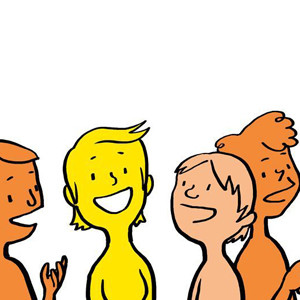
- Do something new, develop confidence, be inspired
- Learn from each other and share ideas
- Find out about new services and ways to help
- Meet people with aphasia from around the world!
If you want to find out more, contact Gill or Denise at
- info@buryspeakeasy.org.uk
- gill@buryspeakeasy.org.uk
- 01706 825802 (part time office)
 Online training login
Online training login 

